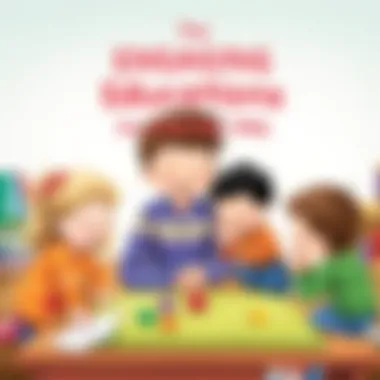Engaging Educational Games for Five-Year-Olds


Intro
Engaging five-year-olds in learning can sometimes feel like herding cats. Their energy and curiosity run high, but finding the right activities that capture their attention can be a challenge. The key lies in educational games that strike a balance between fun and learning. These games not only spark children's imagination but also play a vital role in their cognitive, social, and emotional development. By diving into this article, we’ll explore a plethora of interactive, hands-on games and activities that can enrich the learning experience for kids aged five.
The games we’ll discuss aren’t just mere distractions; they are tools that equip young minds with essential skills. Whether you're a parent looking to keep your little one engaged or an educator hoping to spark creativity in the classroom, the options we describe will help unveil the wonders of learning through play. So, let's roll up our sleeves and jump into the colorful world of engaging educational games!
Understanding Developmental Needs
Understanding the developmental needs of five-year-olds acts as a cornerstone in shaping their learning experiences. At this age, children are buzzing with energy, curiosity, and creativity. Recognizing their developmental milestones can directly influence the types of educational games that engage them effectively. This section delves into the fundamental aspects of what five-year-olds require to thrive, underscores the significance of play, and strikes a balance between fun and learning.
Key Milestones for Five-Year-Olds
Five-year-olds typically hit a variety of milestones that encompass social, cognitive, and physical growth. Recognizing these can help parents and educators select suitable games that meet these evolving needs.
- Cognitive Development: At this age, children’s ability to think logically is blossoming. They start grasping basic math concepts and can follow multi-step instructions. Games that involve counting, sorting, or simple puzzles can stimulate this cognitive process.
- Social Skills: Children are increasingly aware of social interactions. They play better with peers, understanding the basics of sharing and cooperation. Role-playing games or team-based challenges cater to this developing social competence and encourage collaboration.
- Physical Abilities: Improved motor skills are notable at this stage. Activities that challenge their physical skills, like running or climbing, help them develop coordination and balance. Physical games are essential for this growth.
Importance of Play in Learning
Play is not merely a fun distraction for children; it's a vital component of their learning process. In the context of learning, play acts as a medium through which children explore their surroundings and cultivate their skills. Through play, children connect new knowledge with existing understanding.
"Play is the highest form of research." - Albert Einstein
Educational games, whether they involve building blocks or story creation, encourage active engagement. They allow children to manipulate objects, work through problems, and experience the consequences of their actions in a risk-free environment. This immersive form of learning reinforces concepts and skills more effectively than rote memorization alone.
Balancing Education with Entertainment
Finding that sweet spot where fun meets educational value is crucial. While learning is serious business, it doesn't mean it must lack enjoyment. Children learn best when they’re engaged and having fun.
To strike this balance, consider the following tips:
- Make Learning Interactive: Opt for games that require participation rather than passive observation. Tasks that involve hands-on activities keep children actively engaged.
- Incorporate Stories: Integrating narrative elements into games can present complex ideas in relatable ways, making them easier to grasp.
- Assess Engagement: Regularly observe how children respond to different games. If they show disinterest or frustration, it might be time to switch gears. Games should feel accessible yet challenging, keeping the learning process dynamic and adaptable.
By aligning educational theories with the specific developmental needs of five-year-olds, parents and educators can craft an enriching landscape filled with playful learning. This not only fosters knowledge but also nurtures a love for discovery that can last a lifetime.
Categories of Educational Games
When it comes to nurturing the inquisitive minds of five-year-olds, educational games play a pivotal role. These games not only entertain but also serve as vehicles for learning fundamental skills required for their development. By categorizing these games, we can better understand their specific benefits and applications, ensuring that the right type of play is matched to a child's individual needs and interests.


- Physical games encourage movement and coordination while promoting a healthy lifestyle.
- Cognitive games focus on developing critical thinking, problem-solving, and memory skills.
- Art and creativity-oriented games allow children to express themselves and explore their creativity.
- Social interaction through games cultivates teamwork, cooperation, and social skills.
Each category not only enriches the learning experience but also prepares children for future academic endeavors. Let’s break down these categories further to see how they contribute to a child's holistic development.
Digital vs. Traditional Games
As the landscape of education continually evolves, the debate between digital and traditional games has become increasingly relevant, especially when catering to curious five-year-olds. Both forms of engagement provide unique benefits that contribute to learning, yet they also come with considerations that parents and educators must keep in mind. It's crucial to grasp how each type of game aligns with the developmental needs of children at this pivotal age.
Benefits of Digital Learning Games
Digital learning games offer myriad benefits that can complement not only a child’s learning but also their engagement level. These games often come packed with colorful graphics and sounds that easily capture a child's interest. Moreover, they provide a personalized learning experience. For instance, many educational apps adapt their difficulty based on a child’s performance, ensuring that players are always suitably challenged. This adaptability helps maintain motivation and encourages them to push their limits.
Additionally, digital platforms allow for an interactivity that traditional games may lack. Children can explore different learning concepts through immersive experiences and instant feedback. For example, a game that involves building shapes or solving math problems can provide immediate corrections and hints, which promotes active thinking. This instant interaction can be quite stimulating and may resonate more with tech-savvy little ones, steering them to get the most out of learning.
However, moderation is key; digital games should be introduced with awareness of screen time recommendations and considerations of social skills, which can sometimes take a back seat during solo digital play.
Advantages of Hands-on Activities
On the contrary, traditional games keep children engaged with tactile experiences and opportunities to interact face-to-face. Playing a game where they physically build blocks or participate in a group activity fosters a sense of camaraderie. Children learn valuable lessons in teamwork, negotiation, and communication, all while engaging their imaginations. For instance, playing with building bricks not only enhances motor skills but also encourages collaborative problem-solving. This hands-on approach is vital for developing social bonds and understanding the nuances of in-person interaction.
Not to mention, traditional games often involve physical movement. Five-year-olds possess boundless energy, and activities like tag or hide-and-seek are excellent for channeling that energy into play with a purpose. Through these activities, children can develop their coordination and gross motor skills, which are foundational to their overall physical development.
Finding the Right Balance
Striking the right balance between digital and traditional games is essential for optimizing educational outcomes for five-year-olds. A well-rounded approach begins with understanding the individual child's learning preferences and habits. Some children may thrive in a digital environment that offers quick feedback, while others might benefit more from the social interaction that comes from group activities.
Parents and educators should aim for a flexible schedule, alternating between digital and hands-on games during playtime. For instance:
- Incorporate digital games on days when a child shows particular disinterest in more traditional formats.
- Organize playdates that feature cooperative games, allowing space for social skills to flourish.
The goal should be to cultivate a diverse array of experiences that touch on cognitive growth, creative expression, and social interaction. By mixing both digital and traditional games, caregivers can help ensure that children develop a wide-ranging skillset, preparing them for future challenges.
"In the quest for well-rounded development, variety is king."
When thoughtfully blended, digital and traditional games serve as two sides of the same coin, each enriching a child's learning experience in distinct ways. Acknowledging the unique benefits of both will better equip children as they navigate their educational paths.
Creating a Learning Environment


Creating a conducive learning environment for five-year-olds is pivotal in laying the groundwork for their personal and academic growth. At this age, children are naturally curious and eager to explore their surroundings. A thoughtfully designed play area encourages this exploration, making learning both enjoyable and effective. Moreover, a well-structured environment supports the various activities that promote physical, cognitive, and social development.
Setting Up a Play Area at Home
When it comes to setting up a play area at home, it’s not just about having toys scattered around. The placement and accessibility of materials can greatly influence how children interact with their environment. Consider the following points to create an engaging space:
- Designate a Specific Area: Ideally, this space should be free from distractions such as electronics. A well-defined spot helps children understand where they can play and learn freely.
- Age-Appropriate Materials: Stock the area with age-suitable books, educational toys, and games. Use items that can be challenging, yet achievable, to keep the little ones engaged without feeling overwhelmed.
- Incorporate Variety: Include elements that cater to different types of play—such as physical, cognitive, and creative. A mix of blocks, art supplies, puzzles and outdoor gear will keep things exciting while fostering various skills.
- Safety First: Ensure that the area is safe. Remove sharp objects and hazardous materials. Cover electrical sockets and secure any furniture to prevent falls. Little ones are naturally adventurous, and a secure space allows them to explore with confidence.
Involving Families in Educational Play
Family involvement in educational play profoundly enhances a child’s learning experience. Engaging with children not only strengthens family bonds but also creates a supportive learning atmosphere. Here are a few strategies to include families in this educational journey:
- Play Together: Encourage family game nights where everyone participates. Shared activities can motivate children to learn from their parents or siblings, resulting in a richer learning experience.
- Share Responsibilities: Assign family members different roles for educational games. Parental involvement in planning or facilitating these games boosts children's confidence and reinforces learning objectives.
- Discuss and Reflect: After a game, take a moment to share thoughts on what everyone learned. Engaging in a discussion can help children articulate their experiences and reinforce important concepts.
Encouraging Open-ended Exploration
Open-ended exploration is vital in a child’s developmental pathway. It taps into their innate curiosity and creativity while promoting critical thinking. Here’s how to encourage this form of exploration:
- Provide Flexible Materials: Offer materials that can be used in multiple ways. For instance, building blocks can be stacked, sorted, or used in actual play scenarios. This encourages children to think outside the box and use their imagination.
- Limit Structure: While guidance is necessary, too much structure can stifle creativity. Rather than dictating play, allow children to navigate their own learning journey and discover based on their interests.
- Embrace Messiness: Learning often gets a little messy. Encourage open-ended activities like finger painting or sensory bins, where exploration is key. Understand that the process is just as important as the end result.
In summary, fostering an engaging learning environment involves thoughtful consideration of the play area's setup, family involvement, and encouraging open-ended exploration. When children are given the right tools and support, they can thrive in their learning path, setting the stage for a lifelong love of learning.>
For further resources on creating effective play environments, visit Educational Play Resources or check out community discussions on Family Engagement in Learning.
Practical Implementation of Games
To fully grasp the essence of educational games for five-year-olds, it’s paramount to consider how these games can be practically implemented in an everyday setting. Practical implementation refers not only to simply playing games but also to weaving these experiences strategically into the fabric of a child's daily life. The success of educational games hinges on careful planning, adaptability, and ongoing assessment of engagement. This ensures that the games not only entertain but also educate effectively.
Planning Weekly Play Themes
One effective strategy is planning weekly play themes. This involves selecting a specific theme each week that various games can revolve around, offering a focused learning approach. For instance, a week centered on the ocean could incorporate games related to marine life, environmental awareness, and even simple science experiments. This approach aids in cohesive learning and keeps kids engaged.
- Theme Ideas:
- Space Wonders: Games about planets, stars, and astronauts.
- Dinosaur Discovery: Exploration of different dinosaurs through crafts and physical activities.
- Around the World: Learning about different cultures, languages, and traditions.
Using a structured approach helps not only provide clarity and purpose but also allows parents and educators to prepare materials and spaces needed to enhance the learning experience. Planning ahead can cut down on improvisation stresses and increase overall satisfaction for both children and caregivers.


Adapting Games for Individual Needs
Next up is adapting games for individual needs. Every child is unique, possessing different strengths, interests, and learning styles. It’s essential to customize games to fit these diverse needs. For example, if a child struggles with fine motor skills, a traditional puzzle might be too challenging, while bigger, chunky pieces might offer success and boost self-esteem.
- Strategies for Adaptation:
- Simplification: Reduce the complexity of tasks for kids who might find certain activities overwhelming.
- Enhanced Support: Use visual aids or tactile items to assist those who may need extra help.
- Incorporation of Interests: Blend a child’s favorite characters or elements into games to heighten engagement.
Adapting games does not mean watering them down; it means ensuring all kids can participate in a manner that is both enjoyable and learning-focused, facilitating inclusiveness in educational play.
Measuring Success and Engagement
Lastly, there comes the crucial aspect of measuring success and engagement. It’s vital for parents and educators to gauge how well the games are resonating with children. Success can be measured in several ways, not all of which are based on traditional metrics like test scores. Observe how excited a child gets while playing or how often they want to return to a particular game.
- Indicators of Success:
- Increased Participation: More children wanting to join in is a solid sign that the games are appealing.
- Problem-Solving Skills: Noticing that kids are starting to tackle challenges without frustration can indicate cognitive growth.
- Social Skills Development: Improvement in how children interact with peers during games speaks volumes about engagement and learning.
Additionally, periodic feedback from children, regarding what they like or dislike, can guide the planning of future games.
"Playing is the highest form of research." – Albert Einstein
In summation, practical implementation of educational games ensures a structured yet adaptable approach to learning. It cultivates an environment where five-year-olds can thrive and evolve, setting them up for future success. By carefully planning themes, tailoring experiences to fit individual needs, and consistently assessing engagement, educational play becomes more than just fun; it's a vital tool in a child's development.
Epilogue: The Lasting Impact of Educational Play
In the journey of learning, educational play serves as a powerful vehicle, especially for five-year-olds. At this age, children are naturally curious, eager to explore, and ready to soak up knowledge like a sponge. Engaging them in educational games not only captures their attention but also nurtures essential skills that will benefit them throughout their lives.
Educational play cultivates cognitive abilities, social skills, and creativity. When children play, they learn to think critically, solve problems, and navigate social interactions. Consider this: a simple game of "Simon Says" not only encourages listening skills but also enhances ability to follow instructions, thus laying down groundwork for more complex tasks in the future.
"Play is the highest form of research." – Albert Einstein
This quote summarizes the essence of play in learning. By engaging in various forms of play, children learn in a way that feels natural to them, making the educational process both enjoyable and impactful.
Furthermore, educational games can bridge gaps between diverse learning styles. Some children thrive through physical activities, while others excel in imaginative or cognitive games. This synergy allows for inclusivity, accommodating various learning preferences, which is crucial in a classroom or home setting.
Benefits of Educational Play
Play-based learning offers several advantages:
- Enhanced Cognitive Skills: Games like puzzles or memory challenges promote intellectual growth and sharpen problem-solving abilities.
- Improved Social Interaction: Cooperative games encourage teamwork and teach the importance of communication and empathy.
- Fostering Creativity: Art-based games, like storytelling or crafting, unleash children’s imaginations, helping them express themselves uniquely.
Considerations for Caregivers and Educators
Implementing educational play requires thoughtful planning. Here are a few considerations:
- Ensure a balance between structured games and free play that allows kids to explore their interests.
- Tailor activities to fit individual needs. Not every child will engage with the same concepts in the same way.
- Regularly assess what games and activities yield the best engagement and learning outcomes, adapting accordingly.















